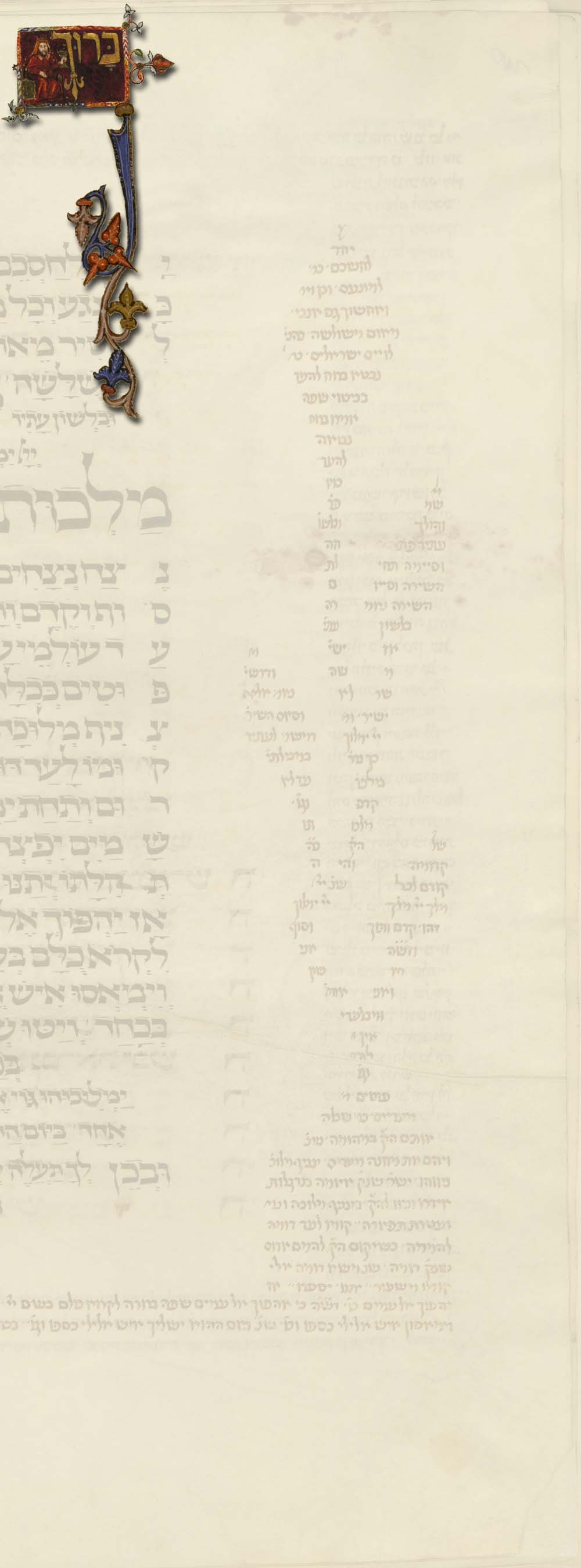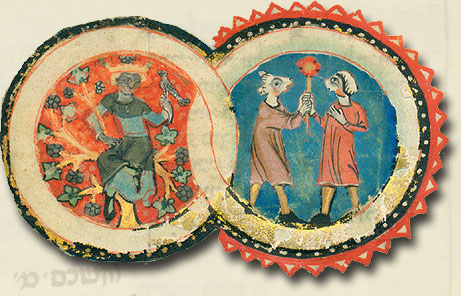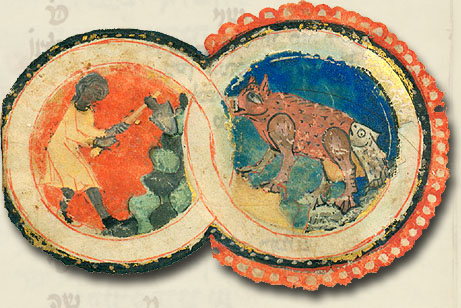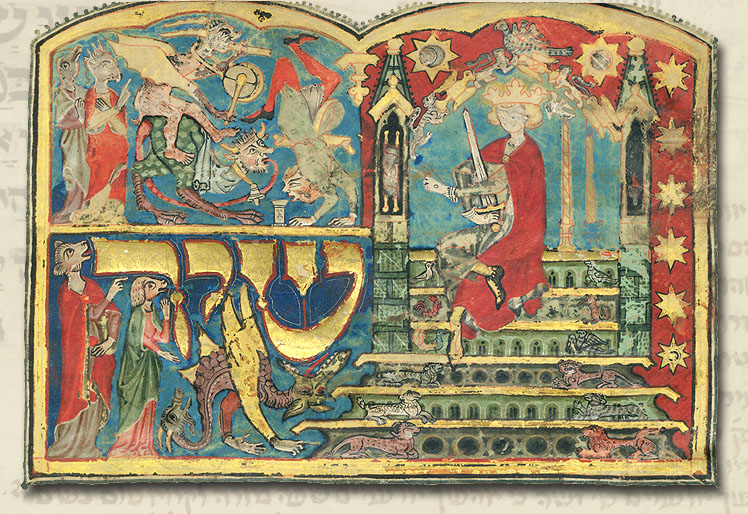





 On account of their iconographical
interest and simple charm let us select some signs of the Zodiac – in this type
of Mahzor they illustrate two piyyuts by Eleazar Kalir (6th c.), the prayer for dew and rain on the
Day of Atonement. The types of representation of the signs of the Zodiac in our
manuscript closely correspond to similar representations in contemporary
Christian calendars, breviaries and psalters. 160
Within the framework of the religio-astrological interpretation of the cosmic
system, the Zodiac represents the signs of the night sky while the illustrations
of the months stand for the earth by representing the labours characteristic of
the given period of the year. 161
The most interesting and most enigmatic of all of them is without doubt the sign
of Gemini. Generally, the
representation of this sign ranges from a transformation of Castor and Pollux as
a caressing pair of a male and female to two armed knights embracing in a fight. 162
In our case we can see two
dog-headed figures facing each other holding an unidentifiable device with a
shaft in their hands (a mirror with a red frame? a shaft or stick with a red
plate? a flower?). 163
It also seems as if the figure on the right had a
On account of their iconographical
interest and simple charm let us select some signs of the Zodiac – in this type
of Mahzor they illustrate two piyyuts by Eleazar Kalir (6th c.), the prayer for dew and rain on the
Day of Atonement. The types of representation of the signs of the Zodiac in our
manuscript closely correspond to similar representations in contemporary
Christian calendars, breviaries and psalters. 160
Within the framework of the religio-astrological interpretation of the cosmic
system, the Zodiac represents the signs of the night sky while the illustrations
of the months stand for the earth by representing the labours characteristic of
the given period of the year. 161
The most interesting and most enigmatic of all of them is without doubt the sign
of Gemini. Generally, the
representation of this sign ranges from a transformation of Castor and Pollux as
a caressing pair of a male and female to two armed knights embracing in a fight. 162
In our case we can see two
dog-headed figures facing each other holding an unidentifiable device with a
shaft in their hands (a mirror with a red frame? a shaft or stick with a red
plate? a flower?). 163
It also seems as if the figure on the right had a
 kerchief on its head,
suggesting that the figures are male and female. 164
Such a representation of Gemini is unknown elsewhere in Europe, and Gotthard
Strohmaier has succeeded in tracing
this motif to the Islamic world at the same time recognizing it also in one of
the enigmatic ornamentations of a mediaeval German altarcloth dating from the
end of the 13th century, the so-called Zehdenicker Altartuch, one of the
treasures of the Märkisches Museum in Berlin. 165
The problem requires further investigation. In the accompanying medallion, in
Müller's and
von Schlosser's view, the female figure can be taken to
represent the idealized love of mediaeval German courtly and knightly love, Frau
Minne, with crown and sceptre, sitting in the flowering branches of a tree and
holding a falcon on her left hand. Narkiss
and Sed-Rajna recognize in this figure the labour of hawking or the
flower-bearer characteristic of the month of Siwan. 166
In Sed-Rajna’s opinion the man is
wearing a crown. Perhaps rather a falconer's cap? In general, both motifs – the
falconer/hawking and man/woman with flowers – were common for April-May-June and
August. 167
Sed-Rajna stresses that the female
figure may hark back to an antique prototype, that of Rosalia, too, representing
the awakening of Nature. 168
The fantastic representation of Cancer, perhaps betraying Oriental influence, is
also remarkable: “a hybrid
animal composed of a wolf’s body and head, a griffon's paws and a fish for a
tail” 169 – this type of representation is unique to our manuscript, it cannot be found
anywhere else. Next to it we see a man digging the soil as the labour of the
month of Tammuz 170
– while the representation of
Scorpion as a tortoise should not
surprise us, because an illuminator living in the vicinity of Lake Constance at
the beginning of the 14th century may not have had the faintest idea what a real
scorpion looked like – the labour of the month of Marheshwan is the vine
harvest. 171
It may be noted in this context that the representation of Scorpion as a
tortoise among the signs of the Zodiac was common in contemporary Christian art,
too. 172
The combined sign of Aquarius and Capricorn radiates a certain rustic atmosphere
with the beautiful sweep (draw-well) and the kid quenching its thirst from the
bucket. Next to it we see in two medallions a sower and a peasant
“holding up a boot while warming his bare foot by the fire, above which hangs a
cauldron.” 173
The figure of a man warming himself by the fire was a widespread motif in the
representation of the winter months (December, January). 174
kerchief on its head,
suggesting that the figures are male and female. 164
Such a representation of Gemini is unknown elsewhere in Europe, and Gotthard
Strohmaier has succeeded in tracing
this motif to the Islamic world at the same time recognizing it also in one of
the enigmatic ornamentations of a mediaeval German altarcloth dating from the
end of the 13th century, the so-called Zehdenicker Altartuch, one of the
treasures of the Märkisches Museum in Berlin. 165
The problem requires further investigation. In the accompanying medallion, in
Müller's and
von Schlosser's view, the female figure can be taken to
represent the idealized love of mediaeval German courtly and knightly love, Frau
Minne, with crown and sceptre, sitting in the flowering branches of a tree and
holding a falcon on her left hand. Narkiss
and Sed-Rajna recognize in this figure the labour of hawking or the
flower-bearer characteristic of the month of Siwan. 166
In Sed-Rajna’s opinion the man is
wearing a crown. Perhaps rather a falconer's cap? In general, both motifs – the
falconer/hawking and man/woman with flowers – were common for April-May-June and
August. 167
Sed-Rajna stresses that the female
figure may hark back to an antique prototype, that of Rosalia, too, representing
the awakening of Nature. 168
The fantastic representation of Cancer, perhaps betraying Oriental influence, is
also remarkable: “a hybrid
animal composed of a wolf’s body and head, a griffon's paws and a fish for a
tail” 169 – this type of representation is unique to our manuscript, it cannot be found
anywhere else. Next to it we see a man digging the soil as the labour of the
month of Tammuz 170
– while the representation of
Scorpion as a tortoise should not
surprise us, because an illuminator living in the vicinity of Lake Constance at
the beginning of the 14th century may not have had the faintest idea what a real
scorpion looked like – the labour of the month of Marheshwan is the vine
harvest. 171
It may be noted in this context that the representation of Scorpion as a
tortoise among the signs of the Zodiac was common in contemporary Christian art,
too. 172
The combined sign of Aquarius and Capricorn radiates a certain rustic atmosphere
with the beautiful sweep (draw-well) and the kid quenching its thirst from the
bucket. Next to it we see in two medallions a sower and a peasant
“holding up a boot while warming his bare foot by the fire, above which hangs a
cauldron.” 173
The figure of a man warming himself by the fire was a widespread motif in the
representation of the winter months (December, January). 174
In perhaps the most famous illustration of the whole manuscript, decorating the frontispiece to the Song of Songs, we see King Solomon seated on his throne in the company of his animals with the Queen of Sheba in front of him, whom the artist has portrayed with an animal's head in the upper left-hand compartment. It seems to be no pure coincidence that Solomon and the Queen of Sheba appear together at the head of the Song of Songs: Solomon is indicated as the author in the title of the work itself, consequently the Lover can easily be identified with him, while a widespread, old tradition going back to Philon of Alexandria and eminently maintained by Isidore of Seville among others identifies the Beloved, the Bride, with the Queen of Sheba. This tradition enjoyed considerable popularity in the Middle Ages. 175
160
Sed-Rajna 1983. 32-37, esp.
32-33. Gerlinde Strohmaier-Wiederanders: Imagines anni. Monatsbilder. Von
der Antike bis zur Romantik. Halle 1999. This latter work deals
extensively and exhaustively with the characteristic representations of
the labours of the months appearing in the medallions accompanying the
signs of the Zodiac. Cf. also Lexikon der christlichen Ikonographie
1968-1976. III. 274-279.
161
Strohmaier-Wiederanders
1999. 46.
162 See
Sed-Rajna 1983. 34
163
Müller – von Schlosser:
Bilderhaggaden 1898. 117. Narkiss
– Sed-Rajna 1988. Tripartite Mahzor, vol. I. Card No. 13.
164 Loc. cit. See also
Sed-Rajna 1983. 34.
 165 Gotthard
Strohmaier: Arabische
Astrologie auf dem Zehdenicker Altartuch. In: Jahrbuch des
Märkischen Museums IV. Berlin 1978. 105-108, 204 (Abb. 31).
165 Gotthard
Strohmaier: Arabische
Astrologie auf dem Zehdenicker Altartuch. In: Jahrbuch des
Märkischen Museums IV. Berlin 1978. 105-108, 204 (Abb. 31).
166
Müller – von Schlosser:
Bilderhaggaden 1898. 117. Narkiss
– Sed-Rajna 1988. Tripartite Mahzor, vol. I. Card Nos 13-15.
167 See
Strohmaier-Wiederanders 1999. 33,
40, 47, 50, 59, 69.
168
Sed-Rajna 1983. 37.
169 Narkiss
– Sed-Rajna 1988. Tripartite Mahzor, vol. I. Card No. 16.
170
Müller – von Schlosser:
Bilderhaggaden 1898. 117-118. Narkiss
– Sed-Rajna 1988. Tripartite Mahzor, vol. I. Card Nos 16-17.
171
Müller – von Schlosser:
Bilderhaggaden 1898. 118. Narkiss
– Sed-Rajna 1988. Tripartite Mahzor, vol. I. Card Nos 24-25.
172
Sed-Rajna 1983. 34.
173 Narkiss
– Sed-Rajna 1988. Tripartite Mahzor, vol. I. Cards Nos 28-30. Cf.
Müller – von Schlosser:
Bilderhaggaden 1898. 118.
174
Strohmaier-Wiederanders 1999. 39,
59, 64, 68, 72, 74 (with a cauldron above the fire),
78.
175
Chastel 1949. 101.
Id.: Fables, formes,
figures. Paris 1978. I. 90-91. Cf. also Edward
Ullendorff: Ethiopia and
the Bible.
 London 1968. 131-145. Giovanni
Canova: Thaclabī.
Storia di Bilqīs, regina di Saba. Venezia 2000. 2-54, 101-108. Aviva
Klein-Franke: Die Königin von Saba in der jüdischen
Überlieferung. In: Die Königin von Saba. Kunst, Legende und
Archäologie zwischen Morgenland und Abendland. Herausgegeben von
Werner Daum. Stuttgart – Zürich 1988. 105–110. André
Chastel:
Regina Sibilla. Ibid. 117-120.
Thaclabī’s
version of the story of Solomon and the Queen of Sheba from his Qisas
al-anbiyâ’ can be consulted in Chrestomathie aus arabischen
Prosaschriftstellern. Ed. by Rudolf Brünnow. (Porta Linguarum
Orientalium, Pars XVI). Berlin–London–New York 1895. 1-22. A remarkable independent development of the
story of the Queen of Sheba can be found in the Legenda Aurea,
where the Queen and Solomon at one point get involved with a piece of
wood out of which the cross of Jesus Christ will be hewn later on, a
fact of course not concealed from the Queen. J.
De Voragine: Die Legenda
aurea aus dem Lat. übersetzt von Richard Benz. Berlin 1963.
378-379.
London 1968. 131-145. Giovanni
Canova: Thaclabī.
Storia di Bilqīs, regina di Saba. Venezia 2000. 2-54, 101-108. Aviva
Klein-Franke: Die Königin von Saba in der jüdischen
Überlieferung. In: Die Königin von Saba. Kunst, Legende und
Archäologie zwischen Morgenland und Abendland. Herausgegeben von
Werner Daum. Stuttgart – Zürich 1988. 105–110. André
Chastel:
Regina Sibilla. Ibid. 117-120.
Thaclabī’s
version of the story of Solomon and the Queen of Sheba from his Qisas
al-anbiyâ’ can be consulted in Chrestomathie aus arabischen
Prosaschriftstellern. Ed. by Rudolf Brünnow. (Porta Linguarum
Orientalium, Pars XVI). Berlin–London–New York 1895. 1-22. A remarkable independent development of the
story of the Queen of Sheba can be found in the Legenda Aurea,
where the Queen and Solomon at one point get involved with a piece of
wood out of which the cross of Jesus Christ will be hewn later on, a
fact of course not concealed from the Queen. J.
De Voragine: Die Legenda
aurea aus dem Lat. übersetzt von Richard Benz. Berlin 1963.
378-379.
176 Narkiss
– Sed-Rajna 1988. Tripartite Mahzor, vol. I. No. 37.
177
Réau 1955-1959. II. I. 289.
Sed-Rajna 1987. 126.
Earlier the identification of the two female figures in the lower left
compartment was not unambiguous: from their gestures
Narkiss concluded that we
might have Solomon's judgement before our eyes.
Narkiss 1967-1968. 133. Cf.
the corresponding scene in the so-called Second Nürnberg Haggadah (fol.
40v), which leaves no doubt as to its interpretation.
Müller – von Schlosser:
Bilderhaggaden 1898. 169-170 [Fol.
40'], Tafel
XXVI. Narkiss – Sed-Rajna
1981. Card No. 164. It may be remarked that in Jewish mysticism, the
Qabbalah, the Queen of Sheba is sometimes identified with Lilith, who in
turn is sometimes regarded as identical with one of the two females
requesting Solomon's decision. Gershom
Scholem: Lilith und die
Königin von Saba. In: Die Königin von Saba 1988. 165.
178
Müller – von Schlosser:
Bilderhaggaden 1898. 119. Sed-Rajna 1983. 29-30. Narkiss – Sed-Rajna 1988. Tripartite Mahzor, vol. I. Cards Nos
34-38. The representation mainly follows the Targum Sheni to Esther
based on 1 Kings 10:18-21.
Sed-Rajna 1987. 126-127, 130 [fig. No.
148]. On the symbolic interpretation of Solomon's throne see
Réau 1955-1959. II. I.
293-294. Lexikon der christlichen Ikonographie 1968-1976. IV.
21-22. King Solomon's seal. Ed. Rachel Milstein. Jerusalem [c.
1995]. 20-28, 183-182 [!].On Solomon's throne in the Islamic tradition
see Priscilla Soucek: Solomon's throne/Solomon's bath: model or
metaphor? In: Ars Orientalis 23 (1993) 113-114.
179 Ibid. 127. Cf. ibid. 155-156.
For another remarkable representation of Solomon's throne see Mathias
Köhler: Bebenhausen.
Klosteranlage und Schloß. (Führer. Staatliche Schlösser und Gärten.)
Heidelberg [c. 2000]. 30.
180
Sed-Rajna 1983. 29-30.
 The Queen, wearing a crown, appears in the company of another zoocephalic
female and “three human-headed hybrid acrobat-musicians playing a pipe and a
tambourine and ringing a bell.” 176
In the lower left-hand compartment we see Solomon's judgement (1 Kings 3:16-28)
– according to a popular tradition the Queen of Sheba assisted at the judgement. 177
The King, wearing gloves, a purple mantle and a crown on his head, and holding a
sword, is sitting cross-legged pointing to the Torah, which is in the right-hand
turret of his throne, while in the left-hand turret there is a lamp – the
eternal light. Behind him two columns of his Temple can be seen. He is encircled
by the Sun, the Moon and the stars. On the steps of his throne sit various
animals. 178
There is only one known parallel in the synagogue at Dura Europos to this most
unique representation, but the difference of nearly eleven centuries between the
two is likely to preclude any direct connection and we must conclude that the
two artists created similar works on the basis of the same text. At the same
time we cannot completely discount the idea that in mediaeval Jewry there
perhaps existed a tradition of the transmission of pictorial representations
going back to Antiquity and still active in the Middle Ages. 179
This representation of Solomon is remarkable because it unites in one
composition, without chronological order, all the main feats of Solomon's
career: the completion of the Temple, the judgement, to which he owes his
reputation of the wise king, and the adoration of the Queen of the South, which
mirrors the universal radiation of his reign. The stars, the Sun and the Moon
echo medieval legends perhaps which attribute cosmic power to Solomon. 180
The Queen, wearing a crown, appears in the company of another zoocephalic
female and “three human-headed hybrid acrobat-musicians playing a pipe and a
tambourine and ringing a bell.” 176
In the lower left-hand compartment we see Solomon's judgement (1 Kings 3:16-28)
– according to a popular tradition the Queen of Sheba assisted at the judgement. 177
The King, wearing gloves, a purple mantle and a crown on his head, and holding a
sword, is sitting cross-legged pointing to the Torah, which is in the right-hand
turret of his throne, while in the left-hand turret there is a lamp – the
eternal light. Behind him two columns of his Temple can be seen. He is encircled
by the Sun, the Moon and the stars. On the steps of his throne sit various
animals. 178
There is only one known parallel in the synagogue at Dura Europos to this most
unique representation, but the difference of nearly eleven centuries between the
two is likely to preclude any direct connection and we must conclude that the
two artists created similar works on the basis of the same text. At the same
time we cannot completely discount the idea that in mediaeval Jewry there
perhaps existed a tradition of the transmission of pictorial representations
going back to Antiquity and still active in the Middle Ages. 179
This representation of Solomon is remarkable because it unites in one
composition, without chronological order, all the main feats of Solomon's
career: the completion of the Temple, the judgement, to which he owes his
reputation of the wise king, and the adoration of the Queen of the South, which
mirrors the universal radiation of his reign. The stars, the Sun and the Moon
echo medieval legends perhaps which attribute cosmic power to Solomon. 180
